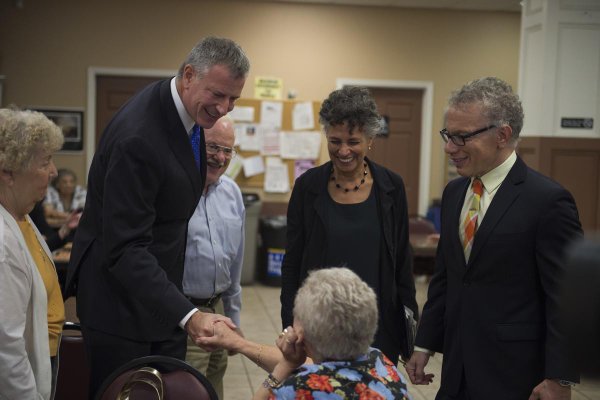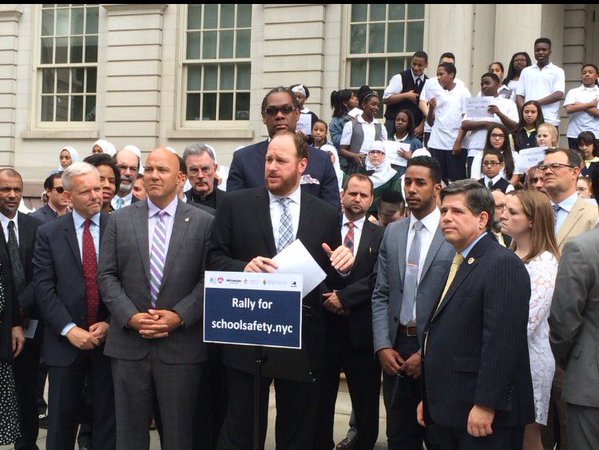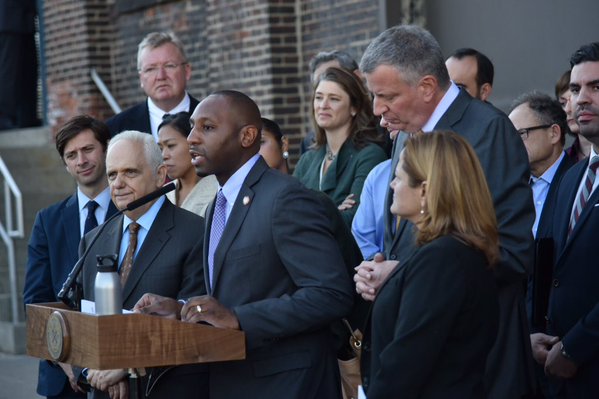A Plan for More Senior Affordable Housing

Mayor de Blasio visits Bronx seniors (photo: @BilldeBlasio)
If there was available land to build affordable senior housing across the city, would you use it? There is. And we must.
The key to using it is passing the de Blasio administration's Zoning for Quality and Affordability plan, which calls for independent senior buildings. There are several reasons this plan makes sense for New Yorkers, of all ages.
LiveOn NY, a leading advocacy organization for older New Yorkers, released Paving the Way for New Senior Housing in May, identifying feasible land that could house 2000 New Yorkers. The city needs to a plan to move forward now - at a certain age, you can't wait.
Why are seniors constantly calling their local City Council members and other elected officials, desperate for affordable housing? Older New Yorkers, the fastest growing demographic in New York City, will comprise an estimated 1.84 million city residents by 2030. Senior households are smaller and poorer on average than the general population. About one in five older New Yorkers live in poverty (below $11,170/year) with many surviving on Social Security alone.
How are seniors impacted by the housing affordability crisis? A shocking 65 percent of senior households living in rent regulated housing, including thousands on SCRIE, spend more than half their income on rent. For those in unregulated buildings the burden is greater. Insufficient affordable housing forces seniors to remain isolated in unsafe or inappropriate housing. This includes living on upper floors of walk-ups or in spaces unable to accommodate a wheelchair.
Tens of thousands of seniors languish on waiting lists in Section 202 buildings for 5-10 years. There are waiting lists to get on waiting lists as primary lists are closed. There are no waiting lists for parking. The choice seems obvious.
Why is utilizing 202-building parking lots one part of the solution to the affordable housing crisis? Land scarcity is the greatest challenge confronting senior housing providers. In the face of a dwindling stock of city-owned land and soaring acquisition costs, 202 parking lots are an untapped source of new land. The lots are owned by local non-profit housing providers mission-driven to provide appropriately sized apartments ensuring senior independence.
Zoning changes would not require eliminating parking, but it becomes a powerful option if in the best interest of the community's elders. Local non-profits have been an integral community partner for decades, providing senior housing and services, and relied upon by local residents and elected officials.
Through the Paving the Way study, LiveOn NY's coalition comprised of leading NYC non-profit senior housing providers, operating 20,000 apartments, found solutions. The knowledge coalition members have of the challenges in building affordable senior housing informed the study. It is critical to understand that the parking lots in question can be used only by residents of the corresponding buildings.
Based on carefully determined criteria, 39 lots in all five boroughs were identified as potentially feasible sites. These sites could be home to at least 2,000 new apartments. With tens of thousands on waiting lists, the potential to house 2,000 seniors cannot be ignored.
Utilizing parking lot land for housing will not take away needed parking spaces. A Department of City Planning analysis found extremely low car ownership rates among 202-building residents, at only five cars per 100 residents in areas near public transportation and 11 cars per 100 residents in areas further from transit.
Many residents have incomes below $15,000 and have aged in place and no longer drive. They are unable to maintain car ownership or have stopped driving. There are waiting lists for apartments; not for parking. Non-profit managers provide vans to assist residents with their daily needs.
Why is the city's Zoning for Quality and Affordability plan necessary to move senior housing forward? Without the enactment of ZQA, the parking lots will sit underutilized - outdated requirements no longer reflect the reality of demand. Nonprofits will be unable to build new housing, whereas ZQA provides options for nonprofits to build more units. It costs $20,000-$50,000 to develop each parking spot. That money could be used for additional apartments, allowing the provider to go deeper into affordability.
Allowing for increased height of one or two floors provides more apartments and ground-floor commercial space. It prevents apartments being on street level, a particularly unsafe practice learned again during Hurricane Sandy.
Accessory amenities are a key component in the neighborhood development approach to keep seniors housed with services. Seniors throughout the community could benefit from using smaller parking lots for medical facilities or senior centers. ZQA facilitates the co-location of services.
How can the city "pave the way" for more senior housing? By enacting ZQA, zoning regulations will be updated to meet the growing need in the coming years and underutilized land – a scarcity in this city – can be used to house 2000 or more seniors.
The need is there. The land is there. Waiting is not an option.
***
Bobbie Sackman is Director of Public Policy, LiveOn NY, a nonprofit organization that makes New York a better place to age. On Twitter: @LiveOnNY.
Public Money Is For Public Schools

Council Member David Greenfield, colleagues, & others rally for Intro 65
Earlier this week the City Council, with the blessing of the mayor, passed Intro 65, a bill that will give $19.8 million of public money to Yeshivas, Catholic, and private schools to pay for security guards. In defending the legislation and public money for private school security as an appropriate use of city funds, Council Member David Greenfield explained that the city is "flush with cash."
His statement about the city being flush with cash is insulting; especially when you look at the district he represents. Mr. Greenfield's district includes part of Borough Park, where the poverty rate is about 32 percent, the same as East New York. Does he think that his constituents feel "flush with cash"?
The City Council, including Mr. Greenfield, are ignoring the realities of the communities they serve and the City as a whole when they pour cash into private institutions and ignore the dire needs of public schools that depend on public funds. Schools throughout the city go without vital resources every day. Yet over and over again, they are told to do more and more with less.
What could nearly $20 million from the City Council do for our public schools? It could be used to add instructional time and expand the school day for dozens of schools struggling to raise student achievement. It could be used to provide social and emotional support services for students and families through community schools, of which there is only one in Greenfield's district, or to provide college counselors in high school, helping to ensure that students apply to and are accepted to schools that best fit them.
Those funds could also be used to spread research-based models of parent engagement throughout the city, to grow the skills and capacity of families to assist in the academic improvement of their children. The funds could be used for translation services for schools like IS 96 in Mr. Greenfield's district, where families speak dozens of languages and struggle to engage in their children's education.
How many students sit in front of outdated computers or go without a library in their schools? If the city is "flush with cash," why are students across New York sitting in schools that are under-resourced and understaffed? The $20 million in public money that will now go to private schools would have been much better spent on schools that are open to all children: public schools.
***
Ayishah Irvin is Coalition for Educational Justice parent leader from Community School District 5.
In Zoning Amendment, One Size Does Not Fit All

Council Member Richards, the author (photo: William Alatriste)
As the de Blasio administration pushes forward its Mandatory Inclusionary Housing (MIH) and Zoning for Quality and Affordability (ZQA) plans coupled together, the City Council plans to take the time to look at these two proposals separately. As chair of the Land Use Subcommittee on Zoning and Franchises, my committee has significant responsibility in this process. One thing is clear: a one-size-fits-all approach will not work.
Community Boards across the city have voiced their concerns about these two plans and we must let them know that we are listening. There are a variety of valid concerns.
As the proposals make their way to the City Council in early 2016, the administration needs to factor in community feedback and make appropriate changes to ensure that the voices of residents are not ignored. We must make sure we are not weakening existing zoning laws or the very process that allows residents to fight to protect the character of their neighborhoods.
After speaking with my colleagues, and as Speaker Melissa Mark-Viverito has said, the Zoning for Quality and Affordability plan will not pass muster in the City Council without changes.
One glaring issue of concern to me that should be removed is the as-of-right policy. We should not be eliminating the need for special permits to build nursing homes and healthcare facilities - doing so would push the city in the wrong direction. The construction of these buildings should have more oversight, not less, and the reason for the current process is to prevent the oversaturation of particular areas that are doing more than their fair share.
Currently, the permit process goes through the Department of City Planning. Developers should have to go through a Uniform Land Use Review Procedure (ULURP). Oversight is essential and communities need to be involved in any planning process that will affect their neighborhood.
While we share the goal of providing housing faster, we must not sacrifice the oversight process in doing so.
As-of-right would also give landowners the ability to remove already existing parking spaces without any due process, which is simply unacceptable to seniors who may come home to find out they are losing the parking spot they rely on.
The goal of reducing parking mandates in areas that the administration has deemed transit hubs is a serious concern, especially in my home borough of Queens, where transit options are limited. Many Queens residents are reliant on their cars and the ability to find parking.
These zones where people have somewhat better access to public transit and there is a focus on decreasing parking need a closer look - it is imperative that city agencies explain how they are going to invest in the infrastructure to account for denser populations. With the city's recent $2.5 billion investment in the MTA capital budget, plans to improve access in these areas need to be included. Simply living near mass transportation does not mean that the infrastructure is at the level it should be to make it a viable option.
We also need assurances that the allowance of a height increase on ground floors will be used for commercial purposes and developers will not be able to turn it into residential space. I would also like to see strategies from the city Economic Development Corporation and the Department of Small Business Services that will ensure the commercial space is used to stimulate economic development in our communities.
While these plans would have an effect on all New Yorkers, Zoning for Quality and Affordability (ZQA) will also have a major impact on seniors in neighborhoods across the city, whether in nursing homes or senior housing developments. The administration must show us that senior housing will contain quality apartments that are not unreasonably small. Seniors are the fabric of our communities and built the groundwork for everything we have today, so we should ensure that we are not limiting their ability to be active.
Due to the complexities of both MIH and ZQA, I am calling for two separate hearings since these plans each deserve their own time in front of the City Council before any final proposal is brought to chambers.
I commend the Department of City Planning for all its work to develop with these proposals and for traveling to communities across the city, and I give Mayor de Blasio and his administration credit for making the affordable housing crisis a priority. But, it is imperative that the final plan for zoning text amendments is the best it can be for all communities. In a city as large and diverse as New York, one size does not fit all.
[Related: Next Steps for The Mayor's Zoning Proposals]
***
City Council Member Donovan Richards, chair of the Land Use Subcommittee on Zoning and Franchises, represents District 31 in Queens, which includes Laurelton, Rosedale, Springfield Gardens and Far Rockaway. He is on Twitter @DRichards13.
***
Have an op-ed idea or submission for Gotham Gazette? E-mail editor Ben Max: This email address is being protected from spambots. You need JavaScript enabled to view it.




